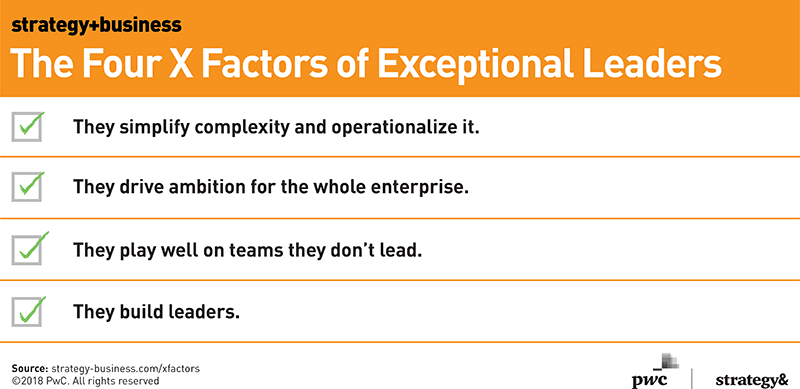The four X factors of exceptional leaders
Understanding what differentiates a great leader from a good leader will help companies make the right choices for the top jobs.
Every February for the last 35 years, the National Football League has run a scouting camp, called a combine, to assess the skills of college players before its annual draft. With scientific precision, the players are evaluated on a number of tests, including the 40-yard dash, bench presses, and vertical leaps. Performance at the combine can affect how early a player is selected in the draft, which is assumed to be a leading indicator of career trajectory. However, many studies (pdf) have shown that although the combine measures the table stakes of athletic skills, it misses the intangibles that make a player stand out come game time. That helps explain why Tom Brady, one of the greatest quarterbacks of all time, was not picked until the sixth round, and star cornerback Richard Sherman was not drafted until the fifth round.
Just as the NFL combine attempts to predict future stars, companies have developed elaborate constructs to answer a seemingly simple question: Which traits distinguish our best future C-suite leaders? Using an array of competency definitions, development planning, and training modules, organizations spend heavily in building their leadership pipelines. Yet when the time comes to distinguish between the “best” leadership candidates and “solid” or “safe” choices, those deciding who to promote frequently struggle — and often miss the signifiers that identify true stars.
Our experience working within hundreds of C-suites and boardrooms around the world has shown us that traditional approaches to senior leader assessment and development often fall short for two distinct reasons.
The first lies in granularity. Measuring a long list of highly specific competencies creates an illusion of validity. In its most common manifestation, this error arises when organizations use the profiles of historically successful leaders within the business to assess the traits of current candidates. Given the pace of change today, those legacy profiles have limited relevance to future requirements. The other side of this “granularity coin” occurs when organizations attempt to imagine all future leadership competencies necessary to deliver the business strategy in five years’ time. Again, the pace of change reduces such highly specific predictions to well-intended guesses.
The second failure point, and one to which boards of directors are particularly susceptible, is a disproportionate focus on skills that should be table stakes. For instance, having a strategic mind-set, delivering P&L performance, and having boardroom presence all make for an attractive C-suite candidacy. But an emphasis on these attributes simply catalogs traits shared by the majority of C-suite players, rather than highlighting the X factors that separate truly outstanding leaders from highly competent ones.
We have sought to address these shortcomings by identifying four specific traits that our research shows the best-performing C-suite leaders share. The analysis is drawn from the real world: As mentors and coaches, we have followed the careers of many C-suite leaders over time. Our data, collected from 2008 to 2018, covers a period that includes the financial crisis and its aftermath, a time marked by disruption across all sectors. We conducted in-depth interviews with more than 2,500 executives, participated in hundreds of C-suite successions, and worked alongside more than 1,000 individual senior executives. Seventy percent of the organizations in the analysis had annual revenues of US$5 billion and higher, and the vast majority were publicly traded. The remaining 30 percent ranged in size from $100 million to $5 billion in annual revenues, and were evenly split between private and public ownership.
In defining “best-performing leaders,” we focused on a number of factors, but gave priority to actual delivery against the organization’s strategy: the clarity and alignment those leaders generated and the pace of the transformation they were able to drive successfully. In other words, we prioritized the “how” of their leadership, while also considering the “what” of their results.
Although our analysis did consider share price as a factor, we weighted it lower than actual performance against strategic goals. For example, one tech company in our data set announced a major shift to mobility and the cloud, and subsequently initiated a round of expensive acquisitions, most of which ended up being wound down or spun off at a discount because they weren’t scalable. The share price remained steady during the period, mainly because of efficiencies created in managing the legacy business, but the future planks of its strategy remained largely unrealized. Our analysis discounted leadership’s effectiveness based on that failure.
In contrast, an energy company in a similar time period committed to shifting from primarily coal- and oil-based operations to renewable solutions, a massive pivot that required a multistage transformation of all aspects of its business model. Over a four-year period, the stock remained flat as the leadership team drove those changes, but as their success in the transformation became apparent, the price began rising. We rated this leadership team successful because they delivered the promised transformation.
When we analyzed our data on all 2,500 leaders, four X factors that distinguish great leaders emerged clearly. Company leaders and boards should understand and recognize these traits.
1. They Simplify Complexity and Operationalize It
As the pace of change and disruption quickens across the world, leaders face an onslaught of new and complex questions. The typical C-suite leader can process vast amounts of data and complexity, often on the fly. “Ability to deal with ambiguity” and “learning agility” have become standard (if unevenly defined) language in executive assessments. Truly standout executives, however, do more than live comfortably with chaos: They take ownership of complexity by creating simple, operational narratives around it that can be readily understood and embraced by those who work for them. This combination of simplifying and operationalizing complexity provides a critical foundation.
Simple, but not simplistic. For many of the business revolutions underway — such as the Internet of Things and blockchain — the endgame is unclear. In the face of this ambiguity, the best leaders strive to create clarity on the problems their business strategy seeks to solve. They emphasize the reasons the organization is uniquely positioned to address those challenges, and offer a simple plan for winning that has just three or four priorities.
“Simply put, leadership is the ability to inspire others to achieve shared objectives, and I think the most important word there by far is ‘inspire.’ It starts with vision, and the clarity of vision that the leader has, and the ability to think about where they ultimately want to take the business, take the company, take the team, take a particular product,” Jeff Weiner, CEO of LinkedIn, told us.
Operationalizing complexity. Creating a simple plan and driving clarity on the problem set that the company’s strategy solves is the first step. The next, and typically harder, one is execution.
Truly standout executives do more than live comfortably with chaos: They take ownership of complexity by creating simple, operational narratives around it.
The best leaders use the simple plan as a foundation for an operational narrative that serves two critical functions. First, it must include one or two simple frameworks for how the company will carry out its strategy. For example, when Brent Saunders (now head of Allergan) became CEO of Bausch & Lomb earlier this decade, he noticed that its engineers seemed overly focused on getting patents and publishing papers. As part of his operational narrative, he switched the name of “R&D” to “D&R” as a constant reminder to employees to focus more on the marketplace and customer. “Success needed to be defined as creating products that mattered,” said Saunders, whose successful turnaround led to IPO preparations before the company was acquired by Valeant Pharmaceuticals.
In addition to providing basic frameworks, an operational narrative should articulate one or two leading indicators by which the organization can track progress at a glance. This is not to suggest that companies replace the array of business unit–specific or role-specific metrics used to measure executive or company performance. Rather, the best leaders are intentional about giving the entire organization a common reference point to track progress toward a long-term goal. “The first thing I have to do is to have people understand where I’m going to take the company,” said Joseph J. Jimenez, former CEO of Novartis International and now on the boards of Procter & Gamble and General Motors. “You have to distill the strategy down to its essence for how we’re going to win, and what we’re really going to go after, so that people can hold it in their heads.”
Operational narratives cascade well. There is no single best approach to developing an operational narrative, and because of changing industry dynamics, the initial frameworks are unlikely to remain static. The most effective leaders constantly test and revise their operating assumptions using new information and insights. But the best operational narratives share several traits:
• They provide a reliable and enduring decision-making process that can be explained briefly and applied at multiple levels and in many contexts.
• They are based on operational realities, not theories, and create an overt, intentional definition of acceptable risk — which may be different from legacy definitions.
• Because they are simple and aligned to the overarching strategy, they provide a gauge for measuring whether a meeting or process has furthered the organization on its path to win, or simply added make-work.
Why emphasize this trait? The ability to simplify complexity may seem like a paradox, and that is precisely the point. The most difficult aspects of leadership are paradoxes, and executives must embrace them fully, and understand that leadership requires a “both/and” skill set. Implementing a simple plan for winning is easier said than done. Most leaders — even very good ones —try to accomplish too many things or get trapped in reactive mode by the problems that crop up or meetings that fill their calendars. True prioritization requires sustained intentionality and operational focus, and becomes a forcing exercise that provides the crucial link between simplifying complexity and operationalizing the leader’s insights.
Once leaders have identified the top three or four priorities that are going to move the needle, they have to weave them into their operational narrative and communicate them constantly. “You can find yourself communicating the same thing so many times that you get tired of hearing it,” Christopher J. Nassetta, CEO of Hilton Worldwide, told the New York Times. “But you can’t stop. What might sound mundane and like old news to me isn’t for a lot of other people.”
Driving clarity deep into the organization with an operational narrative, constant communication, and clear measures of progress is a gritty, relentless pursuit. Not all leaders are up for it.
2. They Drive Ambition for the Whole Enterprise
One of the most powerful momentum-killers in organizations is the well-documented tendency toward silo behavior. We often identify ourselves as a part of a small team, trusting only our immediate circle and perceiving colleagues in other parts of the business as competition for resources rather than part of the collective “us.” Such behavior focuses attention internally, rather than on winning in the marketplace, and can create enterprise blind spots.
To step outside one’s silo and think across the enterprise means overcoming two fundamental human drivers: tribalism and the security that comes from navigating an area one knows well. Achieving enterprise-level thinking requires enough self-awareness to understand these impulses and enough self-discipline to overcome them. The company should be the only “us” that matters, and the discomfort of operating outside one’s area of expertise needs, paradoxically enough, to be a comfort zone for the exceptional leader.
Several years ago, the leader of a well-performing business unit in a global pharmaceuticals company saw the need to shift the dynamic within his team. Although they always hit their financial goals, they operated in silos, a mentality that became apparent when they began to use senior team meetings to catch up on emails rather than listen to what their “outsider” peers were achieving. The leader challenged them to think about their role as contributors within the larger enterprise: What value were they missing in the marketplace by focusing narrowly on individual performance targets? This evolved into a cross-group conversation, and over a period of mere weeks the team members voluntarily redesigned their compensation structure to have more than 50 percent of their incentives measured by the overall performance of the business unit, rather than their individual silos. They also collaborated on stretch goals. As a result, the business unit surpassed its targets, and most of that team’s executives went on to bigger roles. The team leader who sparked the discussion became the CEO.
“I tell people that once you get a job you should act like you run the place,” David Novak, the former CEO of Yum Brands, told us. “Not in terms of ego, but in terms of how you think about the business.… Think about your piece of the business and the total business. This way you’ll always represent a broader perspective.”
3. They Play Well on Teams They Don’t Lead
From the executive leadership ranks on down, teams are the organizing principle of companies. But a clear pattern has emerged from our work with clients: Most business teams have given little thought to what it means to be a true team, despite the growing body of academic and strategic work about the power of the team.
The very best leaders, long before they reach the C-suite, start conversations with their teams with certain questions. What do we need to work on together to accelerate the strategy? What are the three priorities that we must tackle as a team? The answers then drive meeting agendas, guide how decisions are made, and focus communications to the broader organization. “With people at this level of their career, it’s no longer about whether you are the smartest subject matter expert in the room,” said Lynn J. Good, CEO of Duke Energy. “It’s whether you can be effective in leading a diverse team.”
The best C-suite candidates need to play well on teams they are not leading. That can be a challenge for many leaders. As they rise through the ranks, executives are encouraged and incentivized to lead teams. Yet as self-identified alpha types, they are rarely groomed to contribute as a teammate. The most effective executives emphasize the importance of leadership, both individual and collective, as a means of delivering on the strategy — and they focus their contributions to the team on the strategic, rather than on tactical maneuvering. Our polling of more than 100 senior teams in 2016–17 found that the teams that were making the greatest progress toward their stated transformational objectives self-reported that they were dedicating a little more than 50 percent of their time together discussing strategy; those C-suite teams that were moving more slowly were dedicating 90 to 95 percent of their time to tactical conversations.
“The thing I was most focused on early on was, how am I maximizing the effectiveness of the leadership team, and what am I doing to nurture it?” said Satya Nadella of Microsoft, shortly after he took over the chief executive role in 2014. “Are we able to authentically communicate, and are we able to build on each person’s capabilities to the benefit of our organization?”
4. They Build Leaders
In our experience, executives fall into one of two camps. One group sees the people who work for them as assets to help them advance their careers. The other sees the potential of their employees, and takes ownership of the responsibility to develop them. It is not always easy for top leaders, board directors, or human resources executives to accurately discern which camp best describes a particular manager. Some people spend time managing up, creating an impression that they are thoughtful leaders, when they largely ignore the people who work for them. But there is one unambiguous measure for whether a leader builds leaders: his or her track record. Who inside the company has taken on increased responsibility after having worked for the executive?
Our work with succession candidates indicates that a track record of grooming multiple effective leaders is an oft-overlooked measure of authentic leadership capability, yet a reliable predictor of C-suite performance. It is also a measure of self-awareness; people who rise quickly in an organization usually have bosses who are looking out for their best interests. “I don’t think there’s anybody who’s successful in their role today who hasn’t been mentored by somebody,” said Ilene Gordon, the former CEO of Ingredion, a supplier of ingredients to the food industry.
A leader who develops leaders is also more likely to be someone who can retain and develop individuals whose perspectives differ from his or her own. The people a leader chooses to promote are an indicator of the ability (or lack thereof) to create diversity. Diversity isn’t a demographic nicety. It improves strategy execution, and encouraging it is a sign of a leader’s ability to build teams that not only can more rapidly exploit emerging opportunities, but also excel at healthy disruption of the company’s traditional ways of thinking and working.
A disconnect between C-suite leaders and a more diverse rank and file hampers an organization’s ability to hear and process outside perspectives that the organization has worked hard to (and often spent heavily to) recruit. This tension between the need for diverse perspectives and senior leaders’ struggles to hear and process voices that are different from their own is part of a new kind of talent war: the need for greater cognitive diversity everywhere and the increasing mobility of talent. Otherwise competent C-suite candidates who have no track record of grooming and promoting talent with views or profiles different from their own are unlikely to transform magically into champions of diverse thinking once they enter a top role.
The best C-suite leaders actively recruit and engage differing perspectives within their team. They promote nontraditional candidates into stretch roles. Formally or informally, they mentor up-and-comers who look different from and think differently than they do. To win on multiple fronts in a complex world, leaders must build leaders.
How to Develop X-Factor Leaders
These four leadership traits can be cultivated and measured on a variety of objective and subjective levels. Much of the data and capability to measure the traits already lies within organizations, which just need to prioritize what to look for. We see three guiding principles for developing the four leadership traits described above.
First, organizations must decide if they are going to be explicit about reinforcing these traits as measures for success. If yes, the traits must be communicated and reinforced at three different levels to be effective: with the board, with the current C-suite, and within executive development strategies and architecture. This shared framework will drive clarity and alignment throughout a leadership pipeline.
Second, companies should consider adapting the 70-20-10 legacy of traditional development programs for grooming senior leaders. Instead of 70 percent experiential, 20 percent coaching, and 10 percent training, the approach should be more integrated. We advocate a 90-10 model, in which the business strategy and on-the-job context is inextricably woven into any coaching. In this way, coaching avoids the pitfalls of becoming theoretical or strictly behavioral, and instead becomes tied in with experiential development. This 90-10 approach accelerates the “how” of leadership unique to the organization, and helps create separation between the competent and the very best leaders.
Third, organizations must establish a simple but long-range metric or dashboard for tracking the leader’s performance or development on these traits over time and across different roles. Yes, there are clear core deliverables required of any new role, but organizations must also be developing and assessing the X factors of their performance during each assignment.
Business success will always be measured by financial results. These are the “whats” that the leader has delivered, and are powerful lagging indicators. But they are one-sided: They neither qualify nor quantify the “how” of the achievements. Yet the “how” can be the best predictive indicator of a leader’s future performance.
X-factor leaders create a clear worldview — nimble constructs and operational narratives — that everyone buys into. They win by setting the right priorities, building effective teams, and helping the organization step outside its silos to act as one. And they create diverse sets of leaders and teams — not as an intellectual or civic pursuit, but because they view doing so as key to outperforming the market today and tomorrow. Identifying and developing such leaders should be a galvanizing and energizing imperative for organizations seeking to ensure long-term strategic performance.
Author profiles:
- David Reimer is CEO and managing partner of leadership consultancy Merryck & Co Americas. He edits the Executive Roundtable column in the SHRM journal HR People+Strategy.
- Adam Bryant is managing director of Merryck & Co and a former New York Times journalist who created the “Corner Office” interview series. He is author of Quick and Nimble: Lessons from Leading CEOs on How to Create a Culture of Innovation and The Corner Office: Indispensable and Unexpected Lessons from CEOs on How to Lead and Succeed.
- Harry Feuerstein is president of Merryck & Co Americas and the firm’s head of global services. He is a former CEO of Siemens Government Services and managing director of privately held firms.






